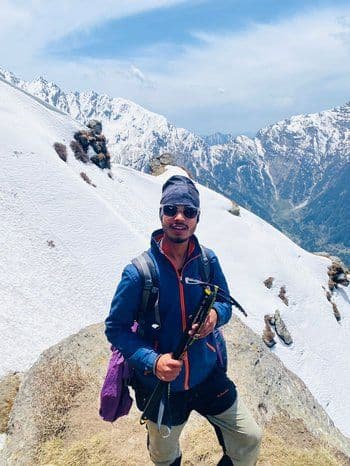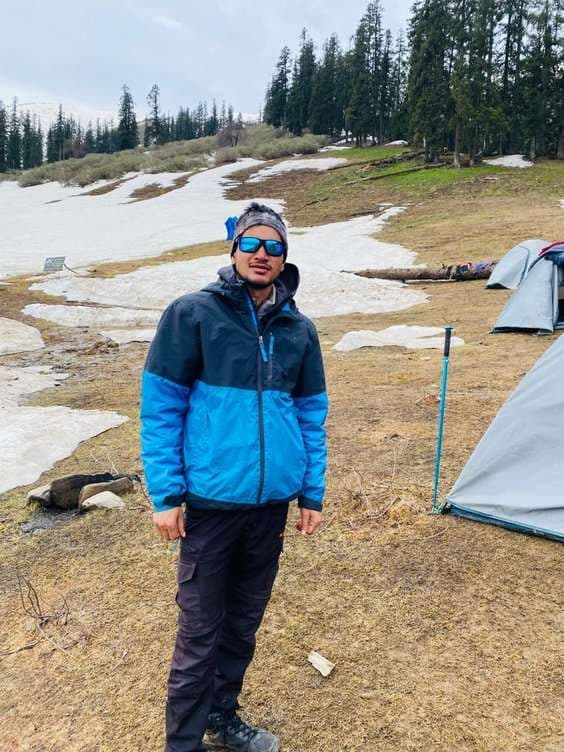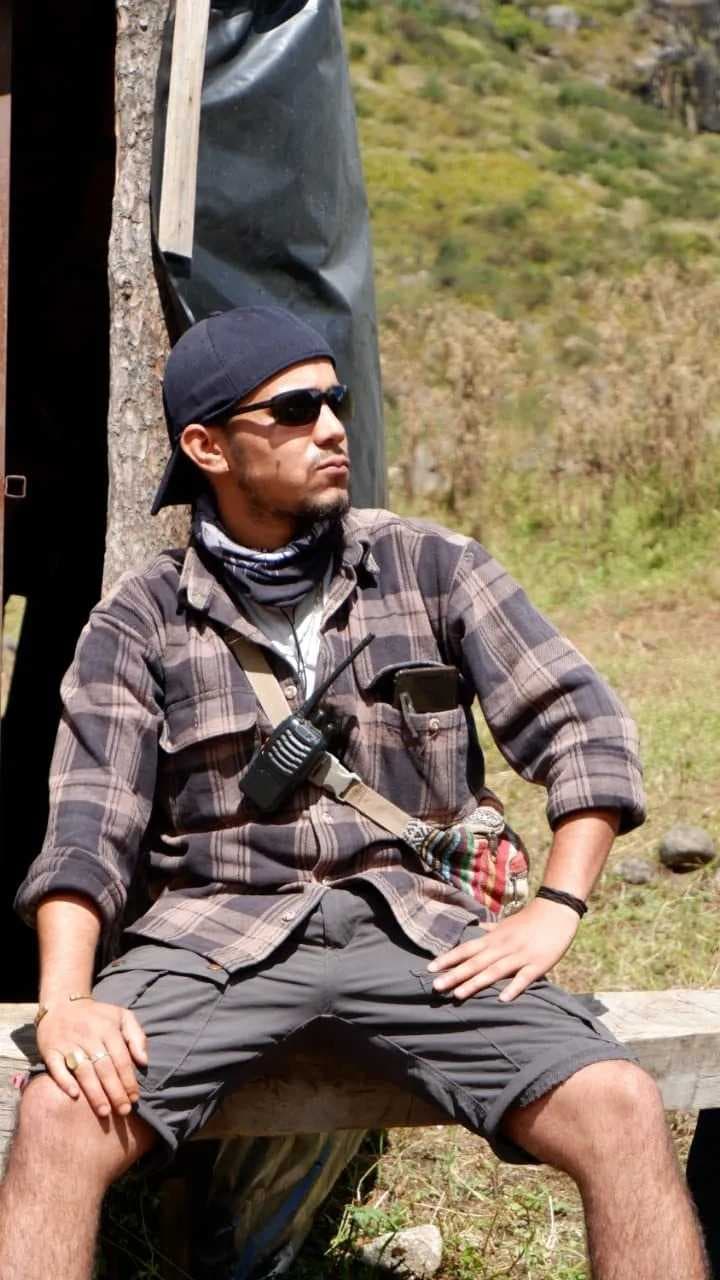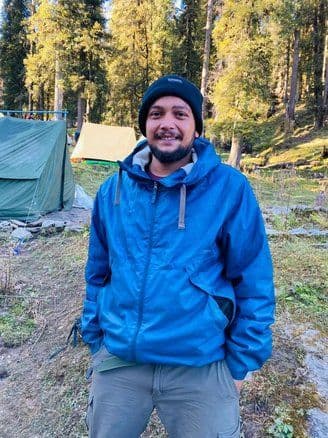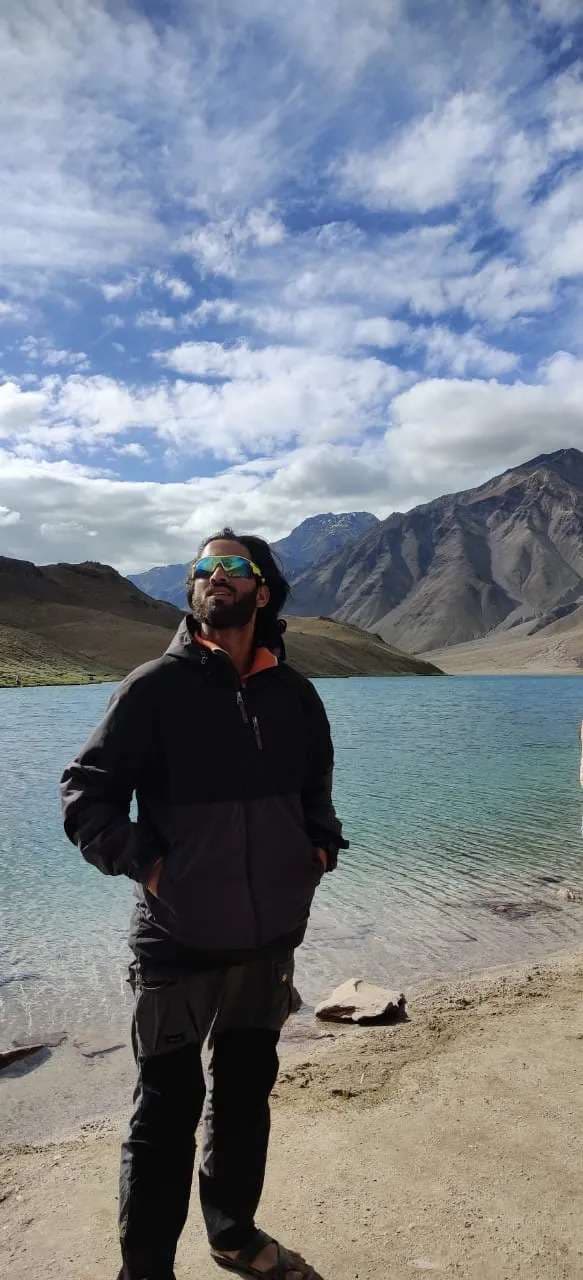Bhagirathi Peak is a prominent mountain peak located in the Garhwal Himalayas of Uttarakhand, India. It is actually a group of three peaks: Bhagirathi I, Bhagirathi II, and Bhagirathi III. Among these, Bhagirathi I is the highest and the most well-known.
Here is some information about Bhagirathi Peak:
1. Bhagirathi I: Also known as Bhagirathi Parbat, this is the highest peak in the Bhagirathi Group and stands at an elevation of approximately 6,856 meters (22,510 feet) above sea level. It is a challenging peak to climb and is part of the Gangotri Glacier region.
2. Bhagirathi II: This is the second-highest peak in the Bhagirathi Group, with an elevation of around 6,512 meters (21,365 feet). Like Bhagirathi I, it is a popular destination for mountaineers and climbers.
3. Bhagirathi III: Bhagirathi III, also known as Bhagirathi III Parbat, is one of the prominent peaks in the Bhagirathi Group of the Garhwal Himalayas in Uttarakhand, India. Bhagirathi III is the smallest of the three peaks, with an elevation of about 6,454 meters (21,175 feet). The trek covers in 19 days approximately and covered 72 km It is often considered the easiest of the Bhagirathi peaks to climb, although it still presents significant challenges. Bhagirathi III is situated in the western part of the Indian Himalayas, specifically in the Garhwal region of Uttarakhand.
Bhagirathi III, like many Himalayan peaks, attracted the attention of mountaineers and explorers in the early 20th century. The first ascent of Bhagirathi III is credited to a British expedition led by T. H. Braham in 1949. This expedition successfully reached the summit of Bhagirathi III, marking a significant achievement in Himalayan mountaineering.
Bhagirathi III, like the entire Bhagirathi Group, is surrounded by glaciers. The Bhagirathi Glacier, one of the primary sources of the Bhagirathi River, lies below the peaks of the group. The region around Bhagirathi III is characterized by rugged terrain, steep slopes, and challenging ice and rock features, making it an attractive destination for mountaineers and climbers seeking adventure and a technical challenge.
Climbing Bhagirathi III requires technical mountaineering skills and experience. It is often considered a less challenging ascent compared to its higher neighbors, Bhagirathi I and Bhagirathi II, but it still presents significant difficulties due to the altitude and the nature of the terrain. Mountaineers attempting to climb Bhagirathi III typically need to obtain permits and adhere to regulations set by the Indian authorities, such as the Indian Mountaineering Foundation (IMF). The ascent to the summit offers breathtaking views of the surrounding Himalayan peaks and the glacier-filled valleys below.
Bhagirathi III, while not as famous as some of the other peaks in the Himalayas, holds historical significance in the world of mountaineering and offers an exciting challenge for those who seek to explore the beauty and adventure of the Garhwal Himalayas. As with any high-altitude climb, thorough preparation, proper equipment, and experienced guides are essential for a safe and successful ascent of Bhagirathi III.
Best Time For Mt. Bhagirathi Peak III Expedition
The best time to attempt a climb of Bhagirathi Peak 3 (Bhagirathi III) in the Garhwal Himalayas of Uttarakhand, India, is during the late spring and early summer months, which typically fall between May-June and September-October. This period is considered the ideal season for mountaineering in the region for several reasons:
1. Weather and Snow Conditions: During late spring and early summer, the weather in the Himalayas is relatively stable, with warmer temperatures at lower altitudes. This results in more favorable climbing conditions, as the snow and ice on the mountain start to melt, making the ascent less treacherous. However, there is still enough snow and ice remaining to facilitate safe crampon and ice axe use.
2. Visibility: Clear skies and good visibility are more common during this period, allowing climbers to enjoy stunning views of the surrounding peaks and landscapes. This is crucial for both safety and the overall experience of climbing in the Himalayas.
3. Avalanche Risk: As the snow starts to melt, the risk of avalanches generally decreases compared to the winter months. However, it's essential to stay informed about current weather conditions and avalanche forecasts.
4. Accessibility: Roads leading to the base camps and trailheads are usually open during this time, making it easier to reach the starting point of your climb.
5. Climbing Window: May and June offer a relatively short but reliable window for climbing Bhagirathi III. As the summer progresses, the monsoon season approaches, bringing heavy rainfall and reduced visibility, making climbing hazardous.
It's important to note that even during the best climbing season, conditions in the high Himalayas can be challenging and unpredictable. Climbers should always be prepared for rapidly changing weather, altitude-related issues, and the technical challenges of the climb. Additionally, obtaining the necessary permits and being aware of any regulations set by the Indian Mountaineering Foundation (IMF) or local authorities is essential for a successful and safe ascent of Bhagirathi III.
Before attempting any mountaineering expedition, it's highly recommended to consult with experienced guides, assess your fitness and climbing skills, and ensure that you have the appropriate gear and equipment for high-altitude climbing. Safety should always be the top priority when planning a Himalayan mountaineering adventure.
How To Reach Dehradun
Dehradun is the capital city of Uttarakhand, India, and it serves as a major gateway to the beautiful Himalayan region. You can reach Dehradun by various means of transportation, including by air, train, and road. Here are the details on how to reach Dehradun:
By Air:
1. Jolly Grant Airport (Dehradun Airport): The nearest airport to Dehradun is the Jolly Grant Airport (DED), which is located approximately 30 kilometers (18.6 miles) east of the city. This airport is well-connected to several major Indian cities, including Delhi, Mumbai, Kolkata, and Bangalore. You can book a domestic flight to Jolly Grant Airport to reach Dehradun.
By Train:
1. Dehradun Railway Station: Dehradun has its own railway station, Dehradun Railway Station (DDN), which is well-connected to various parts of India. Some popular trains like the Shatabdi Express and Mussoorie Express run between Dehradun and Delhi. The railway station is located in the heart of the city, making it a convenient option for travelers.
By Road:
1. From Delhi: Dehradun is approximately 245 kilometers (152 miles) away from Delhi. You can drive to Dehradun from Delhi by taking the NH44 (previously NH72A), which is a well-maintained highway. The journey by road takes around 6-7 hours, depending on traffic and road conditions.
2. From Haridwar/Rishikesh: Dehradun is about 52 kilometers (32 miles) from Haridwar and 45 kilometers (28 miles) from Rishikesh. You can hire a taxi or take a bus from Haridwar or Rishikesh to reach Dehradun in approximately 1.5 to 2 hours.
3. From other parts of Uttarakhand: Dehradun is well-connected by road to other major cities and towns within Uttarakhand. You can use state-run buses, private buses, or hire a taxi to reach Dehradun from places like Mussoorie, Uttarkashi, and Pauri, among others.
(Note: That road conditions in the Himalayan region can vary, especially in hilly areas, so it's a good idea to check the latest road conditions and weather forecasts if you plan to travel during the monsoon season or in winter.)
Once you reach Dehradun, you can explore the city itself or use it as a base to venture further into the scenic Uttarakhand Himalayas, including popular destinations like Mussoorie, Rishikesh, Haridwar, and various trekking routes in the region.
Difficulty Level Of Mt. Bhagirathi III Expedition
Bhagirathi IIII, also known as Bhagirathi Northwest, is a challenging peak in the Indian Himalayas. The difficulty level of the Bhagirathi III expedition is considered high, and it is typically attempted by experienced mountaineers with advanced technical climbing skills.
Here are some factors contributing to the difficulty level of the Bhagirathi III expedition:
1. Technical Climbing: The ascent of Bhagirathi II involves technical climbing on mixed terrain, including snow, ice, and rock. Climbers should be proficient in using mountaineering equipment such as ropes, crampons, ice axes, and other technical gear.
2. Altitude: Bhagirathi II has a significant altitude, and climbers will be operating at high elevations. Acclimatization is crucial to minimize the risk of altitude-related illnesses.
3. Weather Conditions: The weather in the Himalayas can be harsh and unpredictable. Climbers must be prepared for extreme cold, high winds, and rapid weather changes.
4. Duration: The expedition usually requires several days, and climbers need to be physically and mentally prepared for extended periods in challenging mountain environments.
5. Experience Required: Due to the technical nature of the climb and the challenging conditions, participants are generally expected to have prior experience in high-altitude mountaineering and possess advanced technical climbing skills.
It's important to note that the difficulty level of any mountain expedition can vary, and conditions may change from year to year. Before attempting the Bhagirathi III expedition, climbers should undergo thorough training, have the necessary technical skills, and be aware of the potential risks associated with high-altitude climbing.
For the most up-to-date and accurate information on the difficulty level and current conditions of the Bhagirathi II expedition, it is advisable to consult with experienced mountaineering guides, local authorities, or relevant climbing organizations. Additionally, climbers should stay informed about any changes in regulations, permits, and safety guidelines for the specific mountain and region.
Things To Carry For Mt. Bhagirathi peak III Expedition
Climbing Bhagirathi Peak 3 (Bhagirathi III) in the Garhwal Himalayas is a challenging endeavor that requires careful planning and preparation. Here's a list of essential items and equipment to carry for a Bhagirathi Peak 3 expedition:
Personal Gear:
1. Climbing Boots: Sturdy, insulated, and waterproof mountaineering boots with crampon-compatible soles.
2. Crampons: For traction on icy and snowy slopes.
3. Ice Axe: Essential for self-arrest and assistance in steep terrain.
4. Harness: A climbing harness for securing yourself with ropes.
5. Helmet: To protect against falling objects and potential rockfall.
6. Ropes: Dynamic climbing ropes, suitable for glacier travel and roped climbing.
7. Carabiners and Quickdraws: For anchoring and protection.
8. Ascender and Descender: To aid in rope handling during climbs.
Mountaineering Clothing:
1. Layered Clothing: Including base layers, insulating layers, and a waterproof shell.
2. Down or Synthetic Insulated Jacket: For added warmth at higher altitudes.
3. Gloves and Mittens: Insulated and waterproof.
4. Balaclava and Hat: To protect against cold and wind.
5. Gaiters: To keep snow out of your boots.
6. Backpack: A durable and spacious backpack to carry your gear and supplies.
Camping and Shelter:
1. Tent: A sturdy and weatherproof tent for high-altitude camping.
2. Sleeping Bag: Rated for sub-zero temperatures.
3. Sleeping Pad: To insulate yourself from the cold ground.
Navigation and Communication:
1. Map and Compass/GPS: For navigation in the mountains.
2. Satellite Phone: For emergency communication.
Food and Cooking:
1. High-energy Foods: Lightweight, non-perishable foods like energy bars, nuts, and freeze-dried meals.
2. Cooking Equipment: A lightweight stove, fuel, and cookware.
Hydration:
1. Water Bottles/Bladder: Insulated bottles to prevent freezing.
2. Water Purification: Filters or purification tablets to treat water from natural sources.
Medical and First Aid:
1. First Aid Kit: Including basic medical supplies and medications.
2. Personal Medications: Any prescribed medications you may need.
3. Altitude Medication: Consult with a medical professional about altitude sickness medication.
Other Essentials:
1. Headlamp: With extra batteries for night-time activities.
2. Sunglasses: With UV protection and side shields to protect against snow glare.
3. Sunscreen: High SPF to protect against strong mountain sun.
4. Lip Balm: With SPF to prevent chapped lips.
5. Repair Kit: Including tools and materials for gear repair.
6. Backcountry Permit: Ensure you have all the necessary permits and documentation.
7. Cash: In small denominations for emergencies.
8. Toiletries: Including a portable toilet and waste disposal bags.
9. Climbing Permit: Obtain any required permits for Bhagirathi Peak 3 from the relevant authorities.
Remember that this list is a general guideline, and your specific gear requirements may vary depending on the season, weather conditions, and your experience level. It's crucial to consult with experienced mountaineers, guides, or expedition leaders to ensure you have the right equipment and are well-prepared for the challenges of climbing Bhagirathi Peak 3 safely. Additionally, undergo proper acclimatization and physical training before attempting such a high-altitude expedition.
How To Prepare For Mt. Bhagirathi Peak 3 Expedition
Preparing for a Bhagirathi Peak 3 expedition in the Garhwal Himalayas requires careful planning, physical conditioning, and acquiring the necessary skills and equipment. Here's a step-by-step guide on how to prepare for this challenging mountaineering expedition:
1. Obtain Necessary Permits:
Begin by researching and obtaining all the required permits and permissions for the Bhagirathi Peak 3 expedition. This may include permits from the Indian Mountaineering Foundation (IMF) and other local authorities.
2. Physical Fitness:
Physical fitness is crucial for high-altitude mountaineering. Start a comprehensive fitness regimen several months before the expedition.
Focus on cardiovascular conditioning, strength training, and endurance exercises to build stamina and strength.
Incorporate aerobic activities like running, hiking, and cycling into your routine.
Spend time at higher altitudes to acclimatize and adapt to reduced oxygen levels.
3. Technical Skills:
Ensure you have the necessary technical mountaineering skills, such as ice and rock climbing, crevasse rescue, rope work, and glacier travel.
Consider taking mountaineering courses or hiring experienced guides to train and mentor you.
4. Gear and Equipment:
Acquire all the required mountaineering gear, including climbing boots, crampons, ice axes, harness, helmet, ropes, carabiners, and protection devices.
Ensure your gear is of high quality and in excellent condition. Test and familiarize yourself with it before the expedition.
5. Climbing Partners:
Form a team of experienced climbers who share your goals and abilities. Climbing with a knowledgeable and supportive team enhances safety and success.
6. Route Research:
Study the route to Bhagirathi Peak 3 in detail. Understand the terrain, potential hazards, and the best approach for your expedition.
7. Logistics and Supplies:
Plan logistics, including transportation, accommodation, and food for the expedition.
Ensure you have an adequate supply of high-energy foods, cooking equipment, and provisions for the duration of your climb.
8. Medical Preparation:
Get a thorough medical check-up and consult with a doctor experienced in high-altitude medicine.
Discuss and obtain any necessary medications for altitude sickness prevention.
9. Emergency Plan:
Develop a comprehensive emergency plan that includes communication, evacuation procedures, and contact information for rescue services.
10. Training Climbs:
Conduct training climbs on other mountains or peaks to gain experience and assess your readiness for Bhagirathi Peak 3.
Practice your technical skills in real mountain conditions.
11. Acclimatization:
Spend time acclimatizing at higher altitudes, gradually ascending to higher camps before attempting the summit.
12. Leave No Trace:
Familiarize yourself with Leave No Trace principles and commit to minimizing your environmental impact during the expedition.
13. Weather Monitoring:
Keep a close eye on weather forecasts and be prepared to adjust your plans based on changing conditions.
14. Documentation:
Ensure all your documentation, including permits, passports, and emergency contacts, is organized and easily accessible.
15. Communication:
Carry communication devices like a satellite phone or emergency locator beacon for safety and communication with the outside world.
16. Mental Preparation:
Mentally prepare for the challenges and uncertainties of high-altitude mountaineering. Develop a strong mindset for resilience and decision-making.
17. Safety First:
Prioritize safety above all else. Be willing to turn back if conditions become unsafe or if any team member is experiencing health issues.
Remember that Bhagirathi Peak 3 is a challenging climb, and preparation is essential to ensure a safe and successful expedition. Seek guidance from experienced climbers, consider hiring a local guide or expedition company, and always prioritize safety and responsible mountaineering practices during your journey.
Safety Factors Of Mt. Bhagirathi Peak III Expedition
Safety is of paramount importance when undertaking a Bhagirathi Peak 3 expedition or any high-altitude mountaineering adventure in the Himalayas. Here are some crucial safety factors to consider and adhere to during your expedition:
1. Acclimatization: Adequate acclimatization is essential to prevent altitude-related illnesses. Ascend gradually, spend time at intermediate altitudes, and listen to your body. If you or any team member show signs of altitude sickness (headache, nausea, dizziness, etc.), descend to lower elevations immediately.
2. Weather Awareness: Keep a close eye on weather forecasts before and during the expedition. Be prepared to adjust your plans based on changing conditions, and never underestimate the rapid and extreme weather changes that can occur in the mountains.
3. Experienced Guides: Consider hiring experienced local guides or expedition leaders who are familiar with the terrain and weather patterns in the Garhwal Himalayas. They can provide valuable guidance and safety expertise.
4. Communication: Carry reliable communication devices such as a satellite phone or emergency locator beacon (PLB) to stay in touch with your team and for emergency situations. Ensure that someone outside the expedition knows your itinerary and can alert authorities in case of prolonged absence.
5. Team Dynamics: Maintain open and clear communication within your team. Encourage teamwork, mutual support, and the sharing of concerns or observations. Make decisions collectively, and never push forward if any team member is struggling or experiencing health issues.
6. Climbing Ropes and Protection: Use climbing ropes and appropriate protection devices when necessary, especially in technical sections or areas with crevasse hazards. Proper rope management is crucial to prevent accidents.
7. Safety Gear: Carry essential safety gear, including helmets, harnesses, carabiners, ice axes, crampons, and other protective equipment. Inspect your gear regularly and replace any damaged or worn items.
8. Emergency First Aid: Pack a comprehensive first aid kit, including altitude sickness medications and supplies for treating common mountaineering injuries. Ensure team members are trained in basic first aid.
9. Rescue Plan: Develop a detailed emergency rescue plan that includes communication procedures, evacuation routes, and contact information for local rescue services. Be aware of available helicopter rescue options in the region.
10. Avalanche Awareness: Be cautious of avalanche-prone areas, and assess snow conditions regularly. Carry avalanche safety equipment, such as probes, shovels, and avalanche transceivers, when appropriate.
11. Environmental Responsibility: Practice Leave No Trace principles to minimize your impact on the environment. Dispose of waste properly, including human waste, using established procedures for high-altitude areas.
12. Emergency Shelter: Carry emergency shelter equipment like bivouac sacks or tents that can provide shelter in case of unexpected delays or emergencies.
13. Fitness and Health: Ensure that all team members are in good physical condition and health before embarking on the expedition. Stay well-hydrated and well-nourished throughout the climb.
14. Decision-Making: Use sound judgment and prioritize safety over summit objectives. Don't hesitate to turn back if conditions become unsafe or if any member of the team is unwell or injured.
15. Permit Compliance: Ensure you have all the required permits and adhere to local regulations. Non-compliance with permit requirements can lead to legal issues and jeopardize safety.
16. Cultural Sensitivity: Respect local customs and the natural environment. Engage with local communities in a culturally sensitive manner.
Remember that safety should always be the top priority during a mountaineering expedition. Proper preparation, teamwork, communication, and responsible decision-making can significantly reduce.
